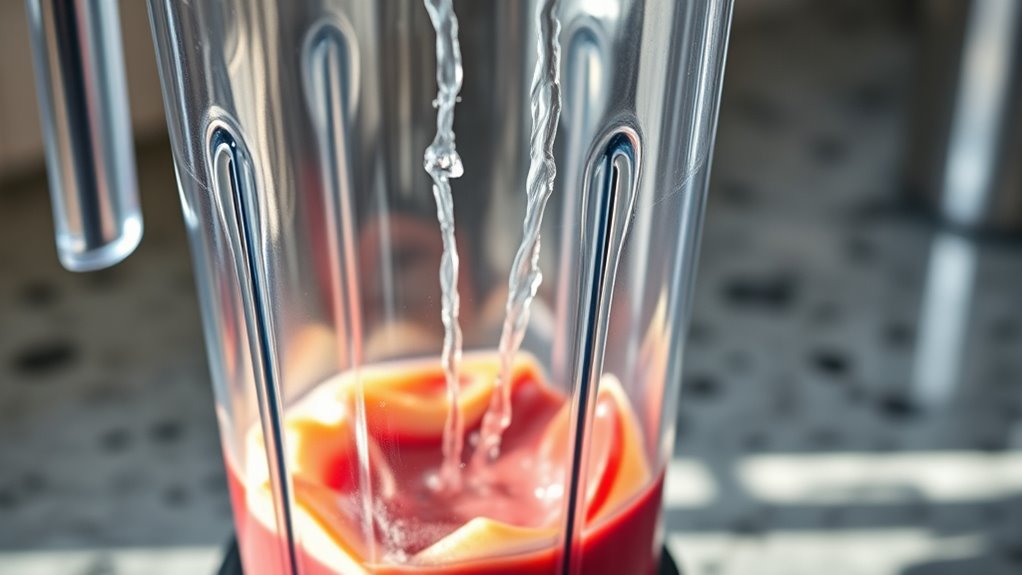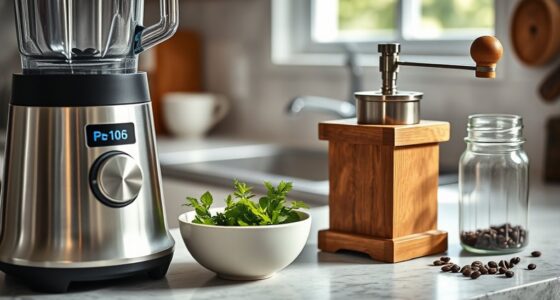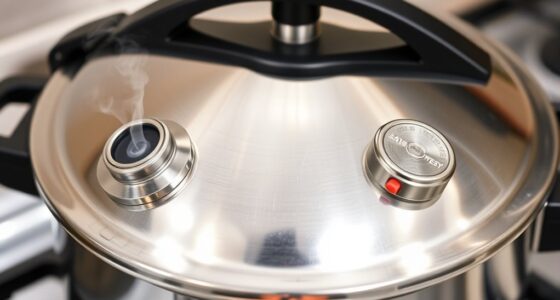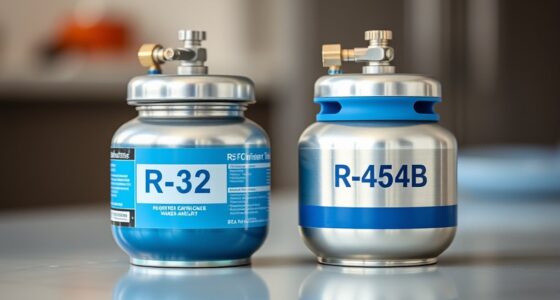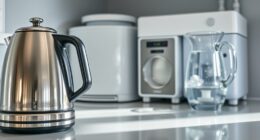To keep your blender running smoothly, regularly check and sharpen the blades using manufacturer-recommended tools like sharpening stones or dedicated sharpeners. Clean the blades thoroughly after each use to remove residue and prevent dullness. Inspect the jar seals, replace damaged gaskets, and ensure all components fit tightly to prevent leaks. These simple maintenance steps improve performance, extend your blender’s life, and help you blend safely and efficiently every time. Keep these tips in mind as you care for your blender.
Key Takeaways
- Regularly inspect and sharpen blades using manufacturer-approved tools to maintain cutting efficiency and prevent motor strain.
- Clean blades thoroughly after each use with soap and a brush to remove residue and prevent dullness.
- Check and replace worn or damaged gaskets and seals to ensure proper jar sealing and prevent leaks.
- Ensure lids are tightly sealed during operation, especially with hot liquids, to maintain safety and blending performance.
- Conduct routine maintenance checks on blades and seals to prolong blender lifespan and optimize performance.

Have you ever wondered how to keep your blender running smoothly for years to come? Proper maintenance begins with understanding the importance of blender blade sharpening and jar sealing techniques. Over time, blades can become dull, making blending less efficient and putting extra strain on your motor. Regularly sharpening the blades ensures they cut through ingredients with ease, maintaining the quality of your blends and extending the lifespan of your appliance. You don’t need to be an expert; a few simple steps can restore your blades to near-original sharpness. Use a sharpening stone or a specialized blade sharpener, carefully following the manufacturer’s instructions. Just be sure to wear gloves for safety and to avoid damaging the blades or sharpening tool. After sharpening, it’s a good idea to clean the blades thoroughly to remove any metal shavings or debris before reassembling the blender.
Equally important are jar sealing techniques, which prevent leaks and maintain vacuum integrity during blending. A loose or damaged seal can cause messy spills and reduce blending efficiency, especially when crushing ice or making smoothies. Inspect your jar’s gasket and sealing ring regularly; if you notice cracks or tears, replace them promptly to prevent leaks. When sealing the jar, ensure the gasket is seated properly in the lid and that the lid twists or snaps into place securely. Proper jar sealing techniques also involve tightening the lid firmly but not overly tight, as overtightening can distort the gasket or damage threads. When blending hot liquids, make sure the jar is sealed tightly to avoid pressure build-up, but leave a small vent or loosen the lid slightly if your blender allows it. Proper sealing not only keeps your kitchen clean but also ensures the motor works efficiently, reducing wear and tear caused by unnecessary strain. Additionally, understanding the proper maintenance strategies can significantly prolong your blender’s lifespan.
Incorporate routine checks into your cleaning process: after every use, inspect the blades for dullness or damage and the jar’s seal for cracks. Cleaning the blades with a brush and soapy water helps keep them sharp and free from residue that could impair performance. Likewise, wiping the sealing ring and lid ensures a tight fit every time you blend. Taking these small steps can markedly improve your blender’s performance and durability. Remember, maintaining sharp blades and proper jar sealing techniques isn’t just about keeping your appliance in good shape; it’s about making your blending experience safer, easier, and more effective. With a little attention and care, your blender will continue serving you well for years to come.
Frequently Asked Questions
How Often Should I Replace My Blender Blades?
You should replace your blender blades when you notice a decline in blade sharpness or if blending becomes less effective. Generally, replacement frequency varies depending on usage, but most blades last about 1 to 2 years with regular use. If you see rust, cracks, or persistent dullness, it’s time to swap them out for new blades to guarantee peak performance and safety during blending.
Can I Use Abrasive Cleaners on Blender Jars?
Sure, go ahead and use abrasive cleaners on your blender jar—if you want to turn that pristine vessel into a scratched, damaged mess. Abrasive cleaners can gouge the surface, risking blender jar damage that ruins its seal and performance. Instead, opt for gentle scrubbing with warm, soapy water or a soft brush. Your blender will thank you with longer life and less damage, saving you money and frustration.
Are There Specific Tips for Cleaning Sticky Ingredients?
To clean sticky ingredients, you should soak the jar in warm, soapy water or use a mixture of baking soda and vinegar to loosen residues. Scrub gently with a brush or sponge, focusing on areas with stubborn buildup. Regularly cleaning your blender helps prevent ingredient buildup and makes cleaning easier. Avoid abrasive cleaners that can damage your jar’s surface, and always rinse thoroughly to keep your blender in top shape.
How Do I Prevent Mold in Blender Jars?
To prevent mold in blender jars, you should regularly clean and dry them thoroughly after each use. Use mold prevention techniques like leaving the lid slightly open to allow airflow and avoiding leftover moisture that causes odors. To keep blender jar odors at bay, add a mixture of baking soda and water, then run the blender briefly. This routine helps eliminate odors and inhibits mold growth effectively.
What’s the Best Way to Store a Blender for Long-Term?
To store your blender long-term, choose a stable storage solution like a cabinet or shelf away from moisture. Make certain the blades are dry and lightly oiled to preserve their sharpness. Store the jar upside down or with the lid off to prevent mold and moisture buildup. Regularly check for dust or debris, and keep the blades protected to maintain their effectiveness, guaranteeing your blender stays in top shape for future use.
Conclusion
Caring for your blender is like tending to a trusted garden—regular maintenance keeps it flourishing. When you clean blades and jars with tender hands, you’re nurturing its engine, ensuring it’s always ready to dance through smoothies and sauces. Think of your efforts as the steady heartbeat that keeps your culinary creations alive and vibrant. With each careful touch, you’re not just maintaining a machine—you’re cultivating a reliable partner that transforms your kitchen into a symphony of flavor.
